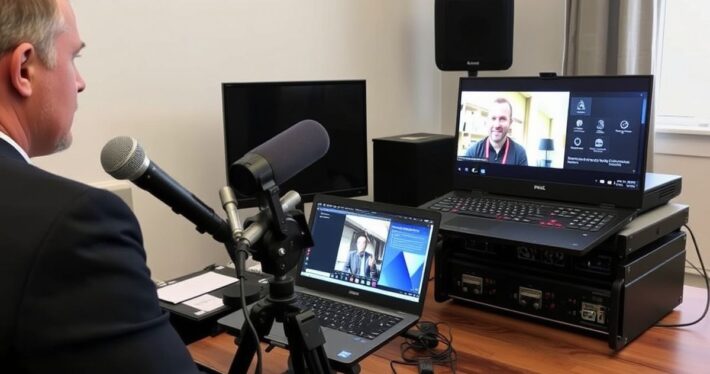The Ideal Timeline for Planning a Webinar

Webinars have become one of the most effective tools for lead generation, audience engagement, and brand authority building. But let’s be honest—pulling off a successful webinar isn’t as simple as throwing together a few slides and hitting “Go Live.” It requires careful planning, strategic execution, and a clear timeline to ensure everything runs smoothly.
In this article, I’ll walk you through the ideal timeline for planning a webinar, whether you’re a seasoned pro or a first-time host. From defining your goals to post-webinar follow-ups, we’ll cover every step to help you create a high-converting event that leaves your audience wanting more.
4-6 Weeks Before: The Foundation Phase
This is where the magic begins. Think of this phase as laying the groundwork for a successful webinar.
Define Your Goals and Audience
What’s the purpose of your webinar? Are you looking to generate leads, educate your audience, or promote a product? Be specific. Once you’ve nailed down your goals, identify your target audience. Who are they? What pain points do they have? Understanding this will help you craft content that resonates.
Choose Your Topic and Format
Your topic should be relevant, engaging, and aligned with your audience’s needs. Will it be a solo presentation, a panel discussion, or a Q&A session? The format matters just as much as the content.
Craft Your Webinar Outline
Using tools like a Slide Outline Creator can be a game-changer here. This AI-powered tool helps you balance education and engagement, ensuring your content flows naturally.
Set a Date and Time
Consider your audience’s time zone and schedule. Mid-week mornings or afternoons tend to work best, but always test what works for your specific audience.
Promote Registration Early
Start promoting your webinar as soon as the date is set. Use email marketing, social media, and your website to drive sign-ups. Early promotion gives you time to build momentum.
2-3 Weeks Before: ThePreparation Phase
Now that the foundation is set, it’s time to get into the nitty-gritty.
Create Your Content
Develop your slides, scripts, and any supporting materials. Tools like Webinar Offer Builder can help you structure your pricing and value stack to maximize conversions.
Plan Your Bonuses and Offers
High-value bonuses can significantly boost conversions. Use a Bonus Brainstormer tool to generate ideas that complement your main offer. For example, if you’re selling a course, throw in a free ebook or a one-on-one consultation.
Set Up Your Tech
Test your webinar platform, microphone, camera, and internet connection. Ensure everything is working smoothly to avoid last-minute hiccups.
Run Promotional Campaigns
Double down on your marketing efforts. Send reminder emails, post on social media, and consider running paid ads to reach a wider audience.
1 Week Before: The Final Touches Phase
At this point, you’re in the home stretch.
Dry Run Your Presentation
Practice your webinar at least once to iron out any kinks. This is also a great time to test your slides, transitions, and timing.
Engage Your Audience
Send a final reminder email with the agenda, key takeaways, and a sneak peek of what’s in store. Building anticipation can increase attendance rates.
Prepare for Q&A
Anticipate common questions and prepare thoughtful answers. If you’re using a Risk-Reversal/Guarantee Generator, make sure your guarantees are clear and compelling.
Day of the Webinar: The Execution Phase
It’s showtime!
Arrive Early
Log in at least 30 minutes before the start time to ensure everything is set up and ready to go.
Engage with Attendees
Greet your audience as they join. A warm welcome can set the tone for the entire webinar.
Deliver with Confidence
Stick to your script but don’t be afraid to go off-script if needed. Authenticity goes a long way in building rapport with your audience.
Close with a Strong Offer
Use your Offer Builder to present a clear, compelling call-to-action. Whether it’s a product, service, or subscription, make it easy for attendees to say yes.
Post-Webinar: The Follow-Up Phase
Your work isn’t done when the webinar ends.
Send a Thank-You Email
Express gratitude to attendees and include a recording of the webinar for those who missed it.
Analyze Your Results
Review attendance rates, engagement metrics, and conversion numbers. What worked? What didn’t? Use this data to improve future webinars.
Follow Up with Leads
Nurture your leads with a series of follow-up emails. Share additional resources, answer any lingering questions, and keep the conversation going.
Real-World Example: Why Timing Matters
Let me share a personal experience. Last year, I hosted a webinar for a client in the fitness industry. We followed this exact timeline and saw a 70% attendance rate and a 40% conversion rate on the backend offer. Why? Because we gave ourselves enough time to promote, prepare, and perfect every detail.
Final Thoughts
Planning a webinar doesn’t have to be overwhelming. With the right timeline and tools, you can create a professional, high-converting event that drives real results. Remember, the key is to start early, stay organized, and focus on delivering value to your audience.
So, are you ready to plan your next webinar? Let’s make it happen!



